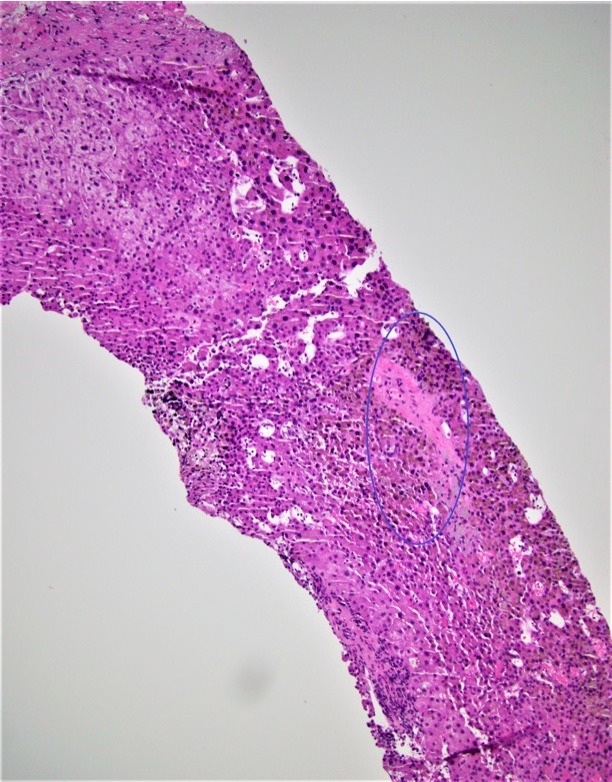Back
Poster Session A - Sunday Afternoon
A0552 - Check Point SOS! A Case of Cemiplimab-Associated Sinusoidal Obstruction Syndrome
Sunday, October 23, 2022
5:00 PM – 7:00 PM ET
Location: Crown Ballroom

Nadeen Sarsour, MD
University of Pittsburgh Medical Center
Pittsburgh, PA
Presenting Author(s)
Nadeen Sarsour, MD, Marta I. Minervini, MD, Shahid Malik, MD
University of Pittsburgh Medical Center, Pittsburgh, PA
Introduction: Hepatic veno-occlusive disease (VOD) or sinusoidal obstruction syndrome (SOS), is a clinical syndrome characterized by hepatomegaly, right-upper quadrant pain, and ascites that occurs most commonly in the setting of high-dose chemotherapy or hematopoietic stem cell transplantation (HSCT). The diagnosis can be confirmed on biopsy. Cemiplimab is an immune checkpoint inhibitor recently approved for the treatment of cutaneous squamous cell carcinoma. There are currently no known reports of immune checkpoint inhibitor-related VOD/SOS.
Case Description/Methods: A 58-year-old female with a history of locally advanced basal cell carcinoma of the left eye treated with six months of Cemipilimab presented with ascites. On admission, labs were notable for a total bilirubin of 1.2, mildly elevated liver function tests, alkaline phosphatase 884, and international normalized ratio 2.1. A diagnostic tap revealed a high SAAG ascites that was negative for infection. A comprehensive serological workup for viral, metabolic and autoimmune causes was unrevealing. A transjugular liver biopsy demonstrated a hepatic venous pressure gradient of 18mmHg, nodular regenerative hyperplasia (NRH), and portal venopathy. The patient was discharged on steroids but returned one month later for recurrent ascites and worsening bilirubin to 12.6 (direct 7.3); COVID PCR was negative. A full rheumatologic and vasculitis workup was unremarkable. Repeat biopsy (figure 1) demonstrated moderate NRH changes, prominent central vein sclerosis with fibrous obliteration, signs of SOS/VOD and central venulitis with fibrotic changes with sinusoidal portal hypertension.
Discussion: VOD occurs most often with hematopoietic stem cell transplantation, and chemotherapeutic agents. Here we present the first case of checkpoint inhibitor-induced VOD/SOS. Despite discontinuation of the offending agent and a trial of steroids, the patient’s clinical course continued to deteriorate. She eventually developed refractory ascites and portosystemic encephalopathy. She was deemed not a candidate for liver transplant given her underlying malignancy. She was transitioned to home hospice before further treatment, such as Defibrotide could have been pursued. VOD associated with immune checkpoint inhibition should be considered in the differential of patients who develop new onset liver dysfunction and ascites while receiving these medications.

Disclosures:
Nadeen Sarsour, MD, Marta I. Minervini, MD, Shahid Malik, MD. A0552 - Check Point SOS! A Case of Cemiplimab-Associated Sinusoidal Obstruction Syndrome, ACG 2022 Annual Scientific Meeting Abstracts. Charlotte, NC: American College of Gastroenterology.
University of Pittsburgh Medical Center, Pittsburgh, PA
Introduction: Hepatic veno-occlusive disease (VOD) or sinusoidal obstruction syndrome (SOS), is a clinical syndrome characterized by hepatomegaly, right-upper quadrant pain, and ascites that occurs most commonly in the setting of high-dose chemotherapy or hematopoietic stem cell transplantation (HSCT). The diagnosis can be confirmed on biopsy. Cemiplimab is an immune checkpoint inhibitor recently approved for the treatment of cutaneous squamous cell carcinoma. There are currently no known reports of immune checkpoint inhibitor-related VOD/SOS.
Case Description/Methods: A 58-year-old female with a history of locally advanced basal cell carcinoma of the left eye treated with six months of Cemipilimab presented with ascites. On admission, labs were notable for a total bilirubin of 1.2, mildly elevated liver function tests, alkaline phosphatase 884, and international normalized ratio 2.1. A diagnostic tap revealed a high SAAG ascites that was negative for infection. A comprehensive serological workup for viral, metabolic and autoimmune causes was unrevealing. A transjugular liver biopsy demonstrated a hepatic venous pressure gradient of 18mmHg, nodular regenerative hyperplasia (NRH), and portal venopathy. The patient was discharged on steroids but returned one month later for recurrent ascites and worsening bilirubin to 12.6 (direct 7.3); COVID PCR was negative. A full rheumatologic and vasculitis workup was unremarkable. Repeat biopsy (figure 1) demonstrated moderate NRH changes, prominent central vein sclerosis with fibrous obliteration, signs of SOS/VOD and central venulitis with fibrotic changes with sinusoidal portal hypertension.
Discussion: VOD occurs most often with hematopoietic stem cell transplantation, and chemotherapeutic agents. Here we present the first case of checkpoint inhibitor-induced VOD/SOS. Despite discontinuation of the offending agent and a trial of steroids, the patient’s clinical course continued to deteriorate. She eventually developed refractory ascites and portosystemic encephalopathy. She was deemed not a candidate for liver transplant given her underlying malignancy. She was transitioned to home hospice before further treatment, such as Defibrotide could have been pursued. VOD associated with immune checkpoint inhibition should be considered in the differential of patients who develop new onset liver dysfunction and ascites while receiving these medications.

Figure: Sinusoidal dilatation and congestion alongside central vein sclerosis. These are common findings of sinusoidal obstruction syndrome on liver biopsy.
Disclosures:
Nadeen Sarsour indicated no relevant financial relationships.
Marta Minervini indicated no relevant financial relationships.
Shahid Malik indicated no relevant financial relationships.
Nadeen Sarsour, MD, Marta I. Minervini, MD, Shahid Malik, MD. A0552 - Check Point SOS! A Case of Cemiplimab-Associated Sinusoidal Obstruction Syndrome, ACG 2022 Annual Scientific Meeting Abstracts. Charlotte, NC: American College of Gastroenterology.
